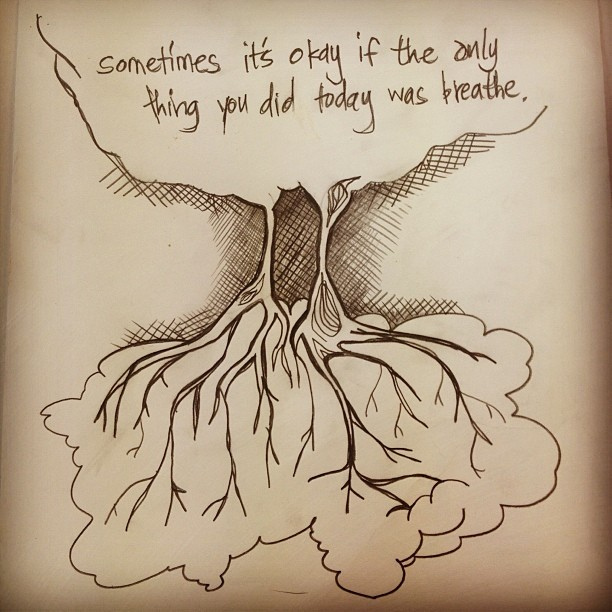One day, as I was teaching yoga to a group of teens and young adults with neurological differences, one of the young men made an insightful and thought-provoking comment:
“You keep telling us to breathe, but we’re already breathing. I mean, if we weren’t breathing, we’d be dead!”
It was a great learning and teaching moment for both of us: I got to teach him what I meant by “breathe,” and he taught me never to assume people know what I’m talking about.
So what exactly does a yoga or meditation teacher mean when when they tell us to breathe?
The controlled breathing we do in yoga—Pranayama—is made up of the two words Prana (life force) and Yama (restraint or control). There are many different types of Pranayama, each with a different Sanskrit name, and each serving a different purpose. There is Ujayii (Victorious) Pranayama, which is the foundation of all other breath types; there is Kumbhaka Pranayama (Breath Retention); Surya Bedhana Pranayama (Single Nostril Breath used to energize or slow energy); Kapalabhati Pranayama (Skull Shining Breath); and even more.
And herein lies a problem for some beginner students:
I have taught yoga to many people who felt lost and defeated from the very first breath because they aren’t sure they’re doing it right, and giving too much direction and explanation seems to make them more confused.
Telling them to “close the back of the throat and make an ocean-sounding breath” can cause great anxiety in some and lead to shut down because they don’t understand it and just can’t feel it. “Close the back of my throat? What is she talking about?” Instead of being able to go with the flow and enjoy the feeling of calm that comes with their own breathing, they get stressed out and feel as if they are failing from the start.
Let’s simplify things.
To me, the goal of breathing isn’t about changing your breath at all. Okay, maybe we slow it and deepen it just a bit, but the main objective is simply to observe it.
That’s it.
Don’t worry about how you’re doing it, just notice that you’re doing it. Notice it the way you notice the breeze blowing the trees outside your window. The cars driving past. Maybe a squirrel picking something out of the grass or the sky darkening with clouds. The same way you can watch a sleeping baby breathing rhythmically, their belly rising and falling, “watch” your own breath coming in and out of your own body.
Observe it without any emotion or judgment, in other words without your inner critic telling you you’re doing it wrong.
Now you’re thinking, “Okay, I’m watching, but, am I doing it right? So I breathe in through my nose and out through my…through my what? Through my nose, or do I open my mouth or what?” Let me tell you a little secret: it just doesn’t matter. The easiest thing is to do all your breathing in and out through your nose, with your lips closed. If that doesn’t feel good to you or if your nose is stopped up, then open your mouth.
Again, it doesn’t matter. There is no grade here. You will not lose points or be demoted in yoga class for breathing incorrectly.
Because you can’t.
Just breathe.
Now notice the way your breath sounds coming in and going out. Really listen to it the same way you hear the quiet hum of traffic or the air conditioner kicking on and off. Notice where you hear it.
Do you hear it in your nose? In your throat? There’s no wrong answer, just listen to it.
Bring your attention to where you feel your breath coming in and out of your body. You might feel your ribs expanding as you inhale, and returning to normal as you exhale. You might notice your belly pushing forward as you breathe in and then falling back toward your spine as you breathe out. Don’t force it, just notice if and where it happens.
Maybe you start to notice your whole body shifting ever so slightly to accommodate the air coming in. Inflating. Filling you up, leaving you feeling a bit floaty. Buoyant. As though you were a hot air balloon and could rise up and into the sky. And as you exhale, notice your body shifting back to its original state. Maybe with the sensation of being a little softer and heavier. Your lower half as the balloon’s basket and sandbags, anchoring you in place, grounding you, connecting you to the earth.
Actively, consciously observe the connection between your breath and your body as though your breathing is a science project. There’s no judgment or emotion or subjectivity, no right or wrong, no opinion—just observation. And as your breath comes in and out, allow yourself to enjoy the way it feels.
Feel it as the gift that it is.
Inhale with the satisfying quality of a yawn that you’ve been stifling and finally surrender to. Exhale with a big sigh as though you’re crawling into bed after a long and tiring day. And then do it again. Let each breath wash through you like fresh water, rinsing and cleaning you out. Sweeping through you, airing out every bit of space, every nook and cranny within you, like a spring cleaning.
Breathe noisily or quietly—it doesn’t matter. Breathe as though you were a sleeping toddler with no awareness of how you look or sound. Breathe as though you’re thirsty for it; as though you can taste it and want more. Savor each lungful of air and then hungrily, insatiably draw in more, each breath renewing you, restoring you to your former self.
Breathe for the joy of it, for the sheer pleasure of being alive.
Do it indulgently, decadently—as though your very life depends on it.
Which it does.
Without fear or doubt. With only trust and a conviction that your body knows exactly what it needs to do.
Just breathe.
Author: Amy Bradley
Editor: Renée Picard
Photo: Buttermilk. at Flickr









Read 0 comments and reply